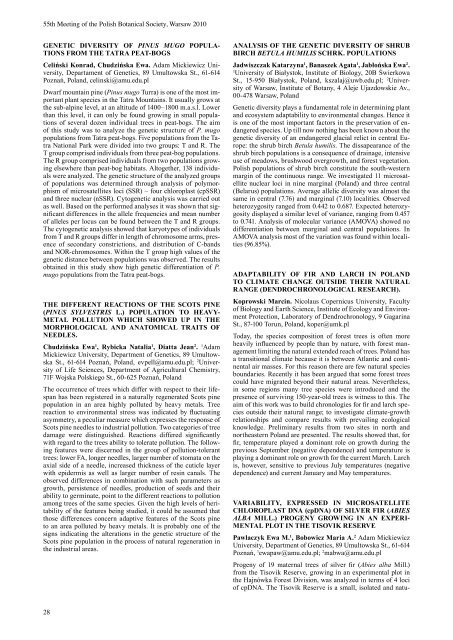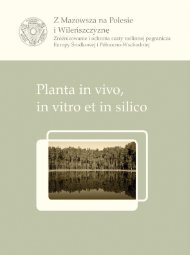acta societatis botanicorum poloniae - LV Zjazd Polskiego ...
acta societatis botanicorum poloniae - LV Zjazd Polskiego ...
acta societatis botanicorum poloniae - LV Zjazd Polskiego ...
Create successful ePaper yourself
Turn your PDF publications into a flip-book with our unique Google optimized e-Paper software.
55th Meeting of the Polish Botanical Society, Warsaw 2010<br />
GENETIC dIVErSITY OF Pinus muGo POPULA-<br />
TIONS FrOM THE TATrA PEAT-BOGS<br />
Celiński Konrad, Chudzińska Ewa. Adam Mickiewicz University,<br />
Departament of Genetics, 89 Umultowska St., 61-614<br />
Poznań, Poland, celinski@amu.edu.pl<br />
Dwarf mountain pine (Pinus mugo Turra) is one of the most important<br />
plant species in the Tatra Mountains. It usually grows at<br />
the sub-alpine level, at an altitude of 1400– 1800 m.a.s.l. Lower<br />
than this level, it can only be found growing in small populations<br />
of several dozen individual trees in peat-bogs. The aim<br />
of this study was to analyze the genetic structure of P. mugo<br />
populations from Tatra peat-bogs. Five populations from the Tatra<br />
National Park were divided into two groups: T and R. The<br />
T group comprised individuals from three peat-bog populations.<br />
The R group comprised individuals from two populations growing<br />
elsewhere than peat-bog habitats. Altogether, 138 individuals<br />
were analyzed. The genetic structure of the analyzed groups<br />
of populations was determined through analysis of polymorphism<br />
of microsatellites loci (SSR) – four chloroplast (cpSSR)<br />
and three nuclear (nSSR). Cytogenetic analysis was carried out<br />
as well. Based on the performed analyses it was shown that significant<br />
differences in the allele frequencies and mean number<br />
of alleles per locus can be found between the T and R groups.<br />
The cytogenetic analysis showed that karyotypes of individuals<br />
from T and R groups differ in length of chromosome arms, presence<br />
of secondary constrictions, and distribution of C-bands<br />
and NOR-chromosomes. Within the T group high values of the<br />
genetic distance between populations was observed. The results<br />
obtained in this study show high genetic differentiation of P.<br />
mugo populations from the Tatra peat-bogs.<br />
THE dIFFErENT rEACTIONS OF THE SCOTS PINE<br />
(Pinus sylvestris L.) POPULATION TO HEAVY-<br />
METAL POLLUTION WHICH SHOWEd UP IN THE<br />
MOrPHOLOGICAL ANd ANATOMICAL TrAITS OF<br />
NEEdLES.<br />
Chudzińska Ewa 1 , rybicka Natalia 1 , diatta Jean 2 . 1 Adam<br />
Mickiewicz University, Department of Genetics, 89 Umultowska<br />
St., 61-614 Poznań, Poland, evpell@amu.edu.pl; 2 University<br />
of Life Sciences, Department of Agricultural Chemistry,<br />
71F Wojska <strong>Polskiego</strong> St., 60-625 Poznań, Poland<br />
The occurrence of trees which differ with respect to their lifespan<br />
has been registered in a naturally regenerated Scots pine<br />
population in an area highly polluted by heavy metals. Tree<br />
reaction to environmental stress was indicated by fluctuating<br />
asymmetry, a peculiar measure which expresses the response of<br />
Scots pine needles to industrial pollution. Two categories of tree<br />
damage were distinguished. Reactions differed significantly<br />
with regard to the trees ability to tolerate pollution. The following<br />
features were discerned in the group of pollution-tolerant<br />
trees: lower FA, longer needles, larger number of stomata on the<br />
axial side of a needle, increased thickness of the cuticle layer<br />
with epidermis as well as larger number of resin canals. The<br />
observed differences in combination with such parameters as<br />
growth, persistence of needles, production of seeds and their<br />
ability to germinate, point to the different reactions to pollution<br />
among trees of the same species. Given the high levels of heritability<br />
of the features being studied, it could be assumed that<br />
those differences concern adaptive features of the Scots pine<br />
to an area polluted by heavy metals. It is probably one of the<br />
signs indicating the alterations in the genetic structure of the<br />
Scots pine population in the process of natural regeneration in<br />
the industrial areas.<br />
28<br />
ANALYSIS OF THE GENETIC dIVErSITY OF SHrUB<br />
BIrCH betulA humilis SCHrK. POPULATIONS<br />
Jadwiszczak Katarzyna1 , Banaszek Agata1 , Jabłońska Ewa2 .<br />
1University of Białystok, Institute of Biology, 20B Świerkowa<br />
St., 15-950 Białystok, Poland, kszalaj@uwb.edu.pl; 2Univer sity of Warsaw, Institute of Botany, 4 Aleje Ujazdowskie Av.,<br />
00-478 Warsaw, Poland<br />
Genetic diversity plays a fundamental role in determining plant<br />
and ecosystem adaptability to environmental changes. Hence it<br />
is one of the most important factors in the preservation of endangered<br />
species. Up till now nothing has been known about the<br />
genetic diversity of an endangered glacial relict in central Europe:<br />
the shrub birch Betula humilis. The dissapearance of the<br />
shrub birch populations is a consequence of drainage, intensive<br />
use of meadows, brushwood overgrowth, and forest vegetation.<br />
Polish populations of shrub birch constitute the south-western<br />
margin of the continuous range. We investigated 11 microsatellite<br />
nuclear loci in nine marginal (Poland) and three central<br />
(Belarus) populations. Average allelic diversity was almost the<br />
same in central (7.76) and marginal (7.10) localities. Observed<br />
heterozygosity ranged from 0.442 to 0.687. Expected heterozygosity<br />
displayed a similar level of variance, ranging from 0.457<br />
to 0.741. Analysis of molecular variance (AMOVA) showed no<br />
differentiation between marginal and central populations. In<br />
AMOVA analysis most of the variation was found within localities<br />
(96.85%).<br />
AdAPTABILITY OF FIr ANd LArCH IN POLANd<br />
TO CLIMATE CHANGE OUTSIdE THEIr NATUrAL<br />
rANGE (dENdrOCHrONOLOGICAL rESEArCH).<br />
Koprowski Marcin. Nicolaus Copernicus University, Faculty<br />
of Biology and Earth Science, Institute of Ecology and Environment<br />
Protection, Laboratory of Dendrochronology, 9 Gagarina<br />
St., 87-100 Torun, Poland, koper@umk.pl<br />
Today, the species composition of forest trees is often more<br />
heavily influenced by people than by nature, with forest management<br />
limiting the natural extended reach of trees. Poland has<br />
a transitional climate because it is between Atlantic and continental<br />
air masses. For this reason there are few natural species<br />
boundaries. Recently it has been argued that some forest trees<br />
could have migrated beyond their natural areas. Nevertheless,<br />
in some regions many tree species were introduced and the<br />
presence of surviving 150-year-old trees is witness to this. The<br />
aim of this work was to build chronologies for fir and larch species<br />
outside their natural range; to investigate climate-growth<br />
relationships and compare results with prevailing ecological<br />
knowledge. Preliminary results from two sites in north and<br />
northeastern Poland are presented. The results showed that, for<br />
fir, temperature played a dominant role on growth during the<br />
previous September (negative dependence) and temperature is<br />
playing a dominant role on growth for the current March. Larch<br />
is, however, sensitive to previous July temperatures (negative<br />
dependence) and current January and May temperatures.<br />
VArIABILITY, ExPrESSEd IN MICrOSATELLITE<br />
CHLOrOPLAST dNA (cpdNA) OF SI<strong>LV</strong>Er FIr (Abies<br />
AlbA MILL.) PrOGENY GrOWING IN AN ExPErI-<br />
MENTAL PLOT IN THE TISOVIK rESErVE<br />
Pawlaczyk Ewa M. 1 , Bobowicz Maria A. 2 Adam Mickiewicz<br />
University, Department of Genetics, 89 Umultowska St., 61-614<br />
Poznań, 1 ewapaw@amu.edu.pl; 2 mabwa@amu.edu.pl<br />
Progeny of 19 maternal trees of silver fir (Abies alba Mill.)<br />
from the Tisovik Reserve, growing in an experimental plot in<br />
the Hajnówka Forest Division, was analyzed in terms of 4 loci<br />
of cpDNA. The Tisovik Reserve is a small, isolated and natu-



